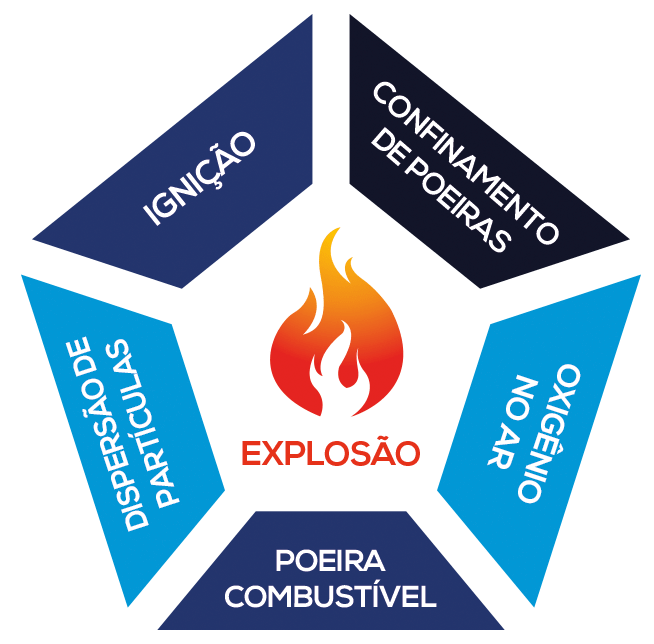Combustible dusts are fine solid particles that can burn or explode when suspended in the air at appropriate concentrations.

The explosion that occurred in a silo in the city of Palotina, in the interior of Paraná/Brazil, drew attention due to the tragic eight fatalities and numerous injuries; however, incidents of this kind are not as rare as one might think. This is because grain storage involves significant risks, especially related to fires and explosions.
It is important to note that industries in the food sector face a high risk of explosion and fire, as most vegetable grains are highly flammable. For example, ethanol is obtained from corn.
What is an explosive atmosphere?
Explosive atmospheres are flammable mixtures of substances such as gases, vapors, dust, or fibers that, when combined with oxygen in the air, can generate devastating explosions. These atmospheres can occur in a variety of industrial environments, from oil refineries to food factories. Identifying the elements present and understanding their properties is essential to prevent incidents.
What are Combustible Dusts?

Combustible dusts are fine solid particles that can burn or explode when suspended in the air at appropriate concentrations and come into contact with an ignition source. These dusts are formed from flammable or explosive substances and can pose significant risks in industrial, agricultural, and other environments where such dust can be generated.
Some examples of combustible dusts include:
- Flour
- Sugar
- Coal Dust
- Wood
- Plastics
Which standard governs combustible dusts in Brazil?
In Brazil, the standard NBRIEC60079-10 2 provides guidelines and parameters related to the classification of areas susceptible to the presence of explosive dusts. These parameters are notably similar to those adopted by the European Community, as specified in the ATEX directives.
To meet these requirements, one of the widely accepted criteria in Brazil and around the world is based on the ATEX directives in force in the European Union countries. This criterion involves categorizing risk areas using a concept known as “Zones,” as illustrated below.
How to prevent explosions from combustible dusts?
Preventing explosions from combustible dusts requires a comprehensive safety approach that involves risk identification, implementation of control measures, and proper employee training. Here are some general guidelines for preventing explosions from combustible dusts:
Risk Identification:
- Identify areas where combustible dusts can be generated or accumulate in your facility.
- Determine the types of dusts involved and their flammable or explosive characteristics.
- Evaluate potential ignition sources, such as electrical equipment, tools, heating systems, open flames, and sparks.
Dust Control:
- Implement dust control practices, such as dust collection and ventilation, to prevent dust accumulation in critical areas.
- Use dust suppression systems, such as controlled humidity or inerting, when applicable.
- Keep work areas clean and organized to minimize accumulated dust.
Explosion-Proof Equipment:
- Use explosion-proof electrical and mechanical equipment in areas where combustible dusts are present.
- Conduct regular equipment maintenance and inspections to ensure they remain explosion-proof.
Ignition Source Control:
- Avoid the operation of equipment that may generate sparks or flames in areas with combustible dusts.
- Implement safe work procedures that minimize the risk of ignition, such as the proper use of spark-proof tools.
Training:
- Provide proper training to employees so they are aware of the risks associated with combustible dusts and know how to act safely.
- Educate workers on emergency procedures in the event of a dust-related explosion or fire.
Regulatory Compliance:
- Be aware of local and national regulations related to preventing explosions from combustible dusts and ensure compliance with these standards.
Risk Analysis:
- Conduct regular risk assessments to identify new potential hazards and ensure that control measures are up-to-date and effective.
Change Management:
- Have procedures in place to manage changes in processes, equipment, or materials that may affect safety related to combustible dusts.
Inspections and Audits:
- Perform periodic safety inspections and audits to ensure that all prevention measures are being followed properly.
How Comquality Engenharia Can Help Your Company?
Comquality Engenharia is the first company in the North-Northeast and the third in Brazil to be certified in the technical competence of ABNT NBR IEC 60079-17, demonstrating our ability to carry out inspection and maintenance of electrical equipment and installations in classified areas.
We have a specialized team focused on delivering optimized solutions in Explosive Atmospheres and Area Classification. Additionally, our professionals hold personal certifications recommended by IECEx, ensuring the quality of our services.
Need assistance with the inspection and maintenance of explosive atmosphere installations in your company? Contact us!
📞 71 3622-1255
📩 comercial@comquality.com.br
🌍 www.comquality.com.br